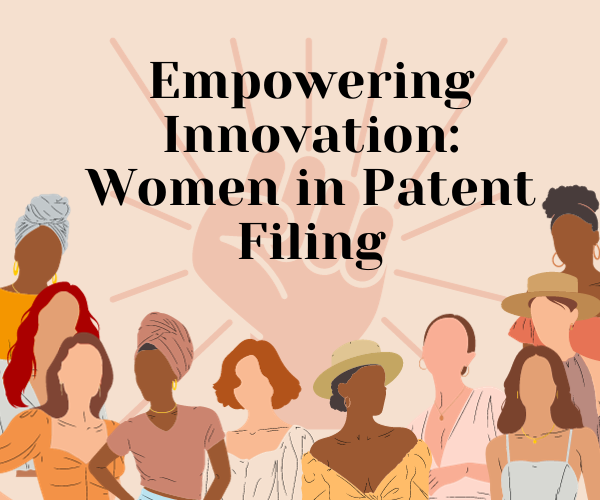Introduction
Innovation has always been at the forefront of progress, driving advancements in technology, healthcare, and countless other industries. While historically, the field of patent filing has been dominated by men, an inspiring shift is taking place. Women inventors are making significant strides, leaving an indelible mark on the world of innovation and intellectual property. This article delves into the profound impacts and innovative contributions of women in patent filing, highlighting their achievements, challenges, and the broader implications for the global landscape of innovation.
Women & Patents
Women have played a vital role in developing the Industry through their inventions. They have helped countries all over the world grow economically. Women have historically faced gender bias across the board, including personally, socially, and professionally, and have been underrepresented in nearly every field. Such biases have long-term effects on all aspects of life, especially in the professional field.
In 1809, Mary Dixon was the 1st Woman to receive the US Patent. She had invented a Process for weaving straw with silk or thread. Her invention gave a head start to the hat industry in the US, and this gave rise to wearable fashion in the 19th century.
In India, the “share” of female inventors who filed patent applications between 2019-2021 was 10.2%. As of 2023, women globally account for 16.2% of all inventors, with men making up the remaining 83.8%.
Challenges & Triumphs
Women patent filers have encountered various challenges and triumphs in their pursuit of obtaining intellectual property rights over their inventions & creative innovations.
Challenges:
Historical Barriers: In the past, women faced a lot of societal and educational barriers that held them back from pursuing higher studies and securing professional opportunities, limiting their access to understanding engineering and technology which are the usual sectors to acquire patents
Gender Bias: Gender bias refers to the prejudice and discrimination that women face in the process of seeking a patent. Women inventors many face challenges in receiving proper recognition for their contribution. The gender stereotypes about women regarding their abilities and interests in technical fields can influence and lead to skepticism and undervaluation of their work.
Lack of Representation: The underrepresentation of women inventors in the public eye can make it difficult for aspiring women inventors to find role models and mentors.
Resource Constraints: Women inventors faced challenges in getting funds to build their inventions and even faced a lack of resources to develop and protect their inventions.
Institutional Hurdles: The patent filing process often involves complex legal and technical language that could be unnerving for inventors who are unaware.
Triumphs:
Ground-breaking Innovations:
Women inventors have made significant contributions to various industries creating Technology and Products that have had lasting impact on societies.
- Josephine G Cochran- Dishwasher
- Margret A Wilcox- Automobile Heater(design used heat from car’s engine to keep drivers and passengers warm)
- Marie Van Brittan Brown- 1st Home Security System
- Revolutionizing Industries:
Women-led innovations have revolutionized industries. For instance, Hedy Lamarr’s work in frequency-hopping technology laid the foundation for modern wireless communication systems, while Grace Hopper’s contributions to computer programming languages transformed the world of computing.
- Entrepreneurial Success: Many women inventors have successfully transitioned from creating inventions to establishing their own companies. Their entrepreneurial ventures have not only led to business success but have generated employment opportunities and economic growth.
- Influence on Policy and Advocacy: Women inventors have been instrumental in advocating for policies that support innovation and intellectual property rights. Their influence extends beyond their inventions, shaping the broader landscape of intellectual property law and innovation policy.
- Recognition of Talent and Expertise: Over time, there has been an increasing recognition of the talent and expertise of women inventors. Awards, honors, and accolades have been bestowed upon them, further validating their contributions to the world of innovation.
- Instilling a Sense of Possibility: Knowing about women’s successes in patent filing instills a sense of possibility in young minds. It encourages them to dream big, believe in their potential, and understand that they too can make meaningful contributions to the world of invention.
Notable Patents Owned by Women:
Margaret E. Knight (1838 – 1914)
Knight, a renowned inventor, invented a machine at 30 that folded and glued paper to create a flat-bottomed paper bag. The machine was so popular that a man stole the idea to patent it. When Knight took him to court for patent interference, he argued that a woman “could not possibly understand the mechanical complexities”. She won by providing proof of design. Over her career, Knight invented over 100 machines and patented 20, including a rotary engine, shoe-cutting machine, and window frame with a sash.
Mary Anderson (1866 – 1953)
In 1902, real estate developer and rancher Mary Anderson discovered a solution to see through falling sleet in a trolley car. She developed a windshield wiper using a lever inside the vehicle to control a rubber blade. Despite initial rejection from car manufacturers, Cadillac became the first to include a windshield wiper on all its vehicles in 1922. After Anderson’s patent expired, windshield wipers became standard equipment, making her invention a significant advancement in the field of windshield wipers.
Melitta Bentz (1873 – 1950)
Bentz, a housewife, was frustrated with the challenges of making coffee, including over-brewing, grounds in the drink, and difficult-to-clean linen bag filters. She invented a filter using blotting paper from her son’s school exercise book and a brass pot perforated with a nail. She obtained a patent and set up a business to manufacture filters. By 1928, her company employed dozens of people. Bentz continued to improve the filter, making it increasingly popular. She was known for her generous bonuses and work schedules and created “Melitta Aid,” a social fund for her workers. The Melitta Group continues to produce coffee, coffee makers, and filters today.
Hedy Lamarr (1914 – 2000)
Hedy Lamarr, an Austrian-American actress and mathematician, was a key figure in the development of GPS, Bluetooth, and Wi-Fi technology. She collaborated with musician and composer George Antheil to improve torpedo technology during World War II. Lamarr’s idea of “frequency hopping” encrypted torpedo control signals, preventing enemy jamming and sending torpedoes off course. Despite receiving a patent in 1942, the US Navy ignored it for 20 years. However, Lamarr’s spread-spectrum technology has become the foundation for portable devices, and she was inducted into the National Inventors’ Hall of Fame in 2014.
Global Perspectives: Women in Patents on the International Stage
Women inventors from different countries bring a rich array of cultural perspectives to the field of patent filing. These unique backgrounds influence the types of innovations they pursue and the problems they aim to solve. For example, innovations in healthcare may be influenced by cultural practices and traditional medicine, while those in technology may address specific regional challenges.
The global perspectives of women in patents promote cross-cultural understanding and appreciation for the diverse ways in which innovation manifests. This not only enriches the global innovation ecosystem but also fosters a sense of interconnectedness in the pursuit of solutions to shared challenges.
Recognizing the global perspectives of women in patents underscores the importance of fostering a collaborative and inclusive environment for innovation on an international scale. By embracing diverse perspectives, we unlock the potential for even greater advancements in technology and solutions to the world’s most pressing issues.
Conclusion: Shaping the Future of Innovation
The contributions of women in patent filing are reshaping the landscape of innovation, demonstrating that diverse perspectives lead to groundbreaking discoveries. As we move forward, it is imperative that we recognize, celebrate, and continue to support the invaluable role that women play in driving progress and pushing the boundaries of what is possible in the world of invention.




